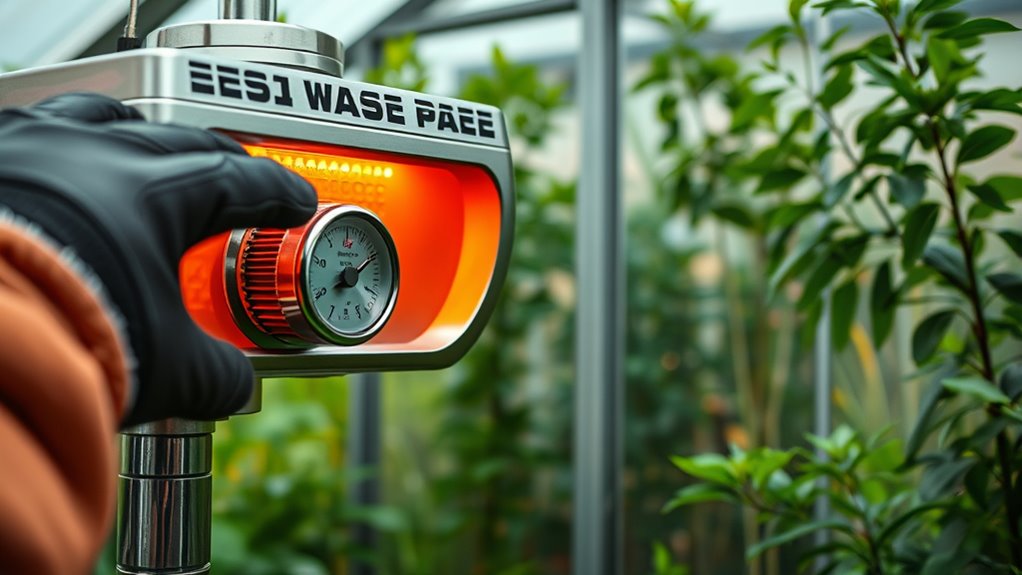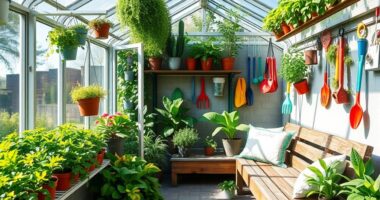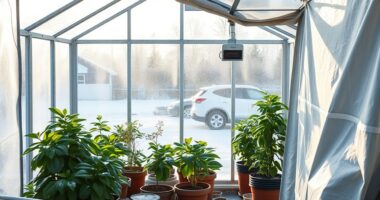To safely use and maintain your greenhouse heater, follow the manufacturer’s guidelines, keep it clean, and inspect cords, fuel lines, or tanks regularly for leaks or damage. Test it in a controlled environment before full use, make certain it’s placed on a stable, non-flammable surface, and keep combustible materials away. Maintain good ventilation and install safety devices like smoke alarms or carbon monoxide detectors. If you want to guarantee reliable operation, keep exploring the best safety practices.
Key Takeaways
- Follow manufacturer’s maintenance guidelines and regularly clean and inspect your heater for leaks or damage.
- Perform pre-use testing in a controlled environment, listening for unusual noises or smells.
- Place heaters on stable, non-flammable surfaces away from combustible materials and ensure proper ventilation.
- Regularly check fuel lines, tanks, cords, and plugs for leaks or wear, and use safety devices like CO detectors.
- Always turn off heaters when unattended, follow safety instructions, and keep the surrounding area clean to prevent fire risks.

Heater safety starts with proper maintenance. Always read the manufacturer’s guidelines for your specific heater model. Clean the unit regularly to remove dust, dirt, and debris that could impair its operation or cause overheating. If your heater uses fuel, inspect fuel lines and tanks for leaks or blockages. For electric heaters, ensure cords and plugs are in good condition, with no fraying or exposed wiring. Performing these routine maintenance tasks reduces the risk of malfunctions and extends the life of your equipment. It’s also wise to test your heater in a controlled environment before using it in the greenhouse. Turn it on for a short period, observe its operation, and listen for unusual noises or smells, which could indicate underlying issues. Additionally, understanding the basic principles of heater operation can help you troubleshoot minor problems and ensure efficient performance.
When your heater is in use, make sure it’s placed on a stable, non-flammable surface away from any combustible materials like paper, fabric, or dry plant matter. Adequate ventilation is equally important to prevent the buildup of dangerous gases or carbon monoxide, especially if your heater is fuel-powered. Install carbon monoxide detectors or smoke alarms nearby as an extra safety measure. Never leave your heater unattended for long periods, and always turn it off when not in use or when you leave the greenhouse. These precautions are part of good heater safety practices, which help you prevent accidents and ensure your heating system operates reliably throughout the winter.
Frequently Asked Questions
How Often Should I Replace Greenhouse Heater Filters?
You should replace your greenhouse heater filters every 1 to 3 months, depending on usage and the level of dust or debris in your environment. Regular heater maintenance includes sticking to a consistent filter replacement schedule to guarantee peak performance and safety. Check the filters monthly and replace them when they appear dirty or clogged. Proper filter maintenance helps prevent strain on your heater and maintains a healthy greenhouse environment.
What Are the Signs of a Faulty Thermostat?
If your thermostat isn’t maintaining proper temperature, it might be faulty. Signs include inconsistent readings, the heater turning on or off unexpectedly, or the temperature not matching the thermostat setting. Check for faulty wiring or calibration issues, as these often cause problems. Regularly test and calibrate your thermostat to ensure accurate readings, and inspect wiring connections to prevent malfunctions that could compromise your greenhouse environment.
Can I Use Outdoor Heaters Indoors Safely?
You shouldn’t use outdoor heaters indoors without proper safety precautions and heater installation. These heaters are designed for outdoor use and may produce harmful fumes or pose fire risks indoors. Always check the manufacturer’s guidelines, make sure there is adequate ventilation, and install the heater according to safety standards. If in doubt, consult a professional to ensure safe indoor use, preventing accidents and maintaining a safe environment.
How Do I Troubleshoot Uneven Heat Distribution?
If your greenhouse’s heat is acting like a wild roller coaster, start by checking your heat sensors—they might be giving faulty readings. Use insulation techniques like bubble wrap or foam panels to even out temperature zones. Make certain your heater’s placement isn’t causing hot spots or cold corners. Adjust vents and fans to promote better airflow. Troubleshooting uneven heat distribution keeps your plants cozy and thriving, no matter how unpredictable the weather gets.
Are There Eco-Friendly Heater Options for Greenhouses?
Yes, you can choose eco-friendly heater options like solar-powered systems and biomass heaters for your greenhouse. Solar options harness sunlight, reducing energy costs and emissions, making them sustainable. Biomass heaters burn organic materials like wood pellets or crop waste, providing renewable heat. Both options help lower your carbon footprint while maintaining ideal temperatures. By investing in these eco-friendly solutions, you support environmental conservation and create a more sustainable greenhouse environment.
Conclusion
By regularly checking and maintaining your greenhouse heater, you’ll keep your plants safe and thriving. Think of your heater like a trusted guardian, silently working to protect your crops through every cold snap. When you stay vigilant and follow proper safety practices, you prevent small issues from snowballing into big problems. Remember, a well-maintained heater is the heartbeat of a healthy greenhouse—keep it steady, keep it strong, and watch your garden flourish.









